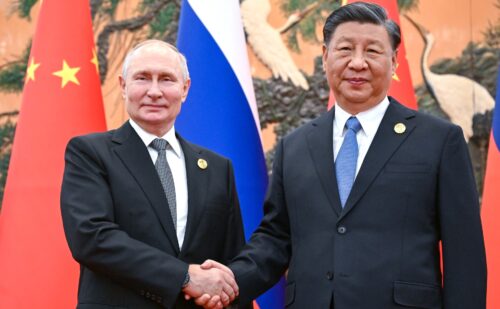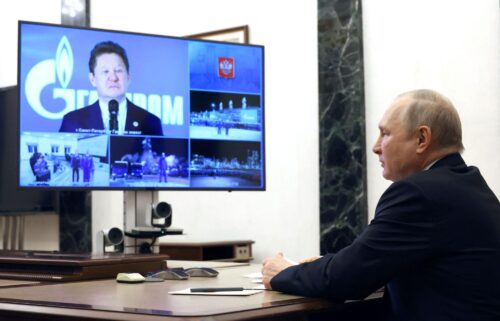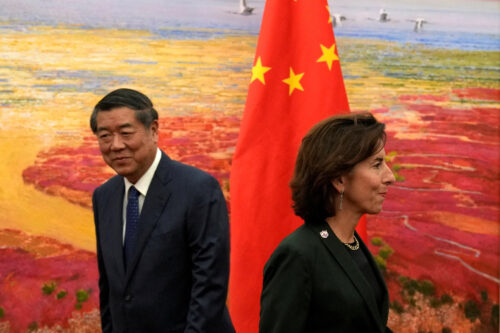Understanding the Trump-China trade tangle: What happens next?

President Donald Trump signed a memorandum on March 22 to impose taxes on $50 billion worth of imported Chinese goods. China just responded by announcing tariffs on 106 items, which will match the U.S.’s projected monetary impact, targeting everything from airplanes to agriculture.
But the important thing to note is that Trump’s memorandum is just that — a memorandum directing the U.S. Trade Representative to consider implementing tariffs. No “China-only” tariffs have actually taken effect or even been approved at a governmental level.
While U.S.-China trade spats have been going on for years, this most recent skirmish began in January, when Trump hiked taxes on all American imports of solar panels and washing machines (save for NAFTA partners Mexico and Canada) in a move to protect American producers of both.
The president’s ability to make this call was made possible after a few solar panel companies filed a special petition last spring under the 1974 Trade Act, which essentially granted the U.S. an escape from the General Agreement on Trades and Tariffs (GATT) — the international trade rules adopted by 153 countries around the world. According to Section 201 of the U.S.’s 1974 Trade Act, if “serious injury” is being inflicted on a U.S. industry due to foreign imports, the president is offered sole authority to implement special protections.
It is interesting to note that this provision is rarely used, mostly because presidents have been concerned about retaliation tariffs. Since 1974, there have been 74 investigations, but just nine of those resulted in tariffs. Then again, Trump was never one for following precedence.
Why Trump’s supporters may be the most affected
While many economists agree that, from a trade perspective, bringing jobs back to the U.S. is not going to produce any long-term, net-positive results for the country, it will protect and preserve — at least in the short term — the jobs of those who put Trump in office. Thus, these acts fit the definition of protectionist policies.
While Trump is working to support those industries that employ some of his biggest supporters, targeting markets is a game two can easily play. “The Chinese read American press,” said Kevin Nealer, principal with the Scowcroft Group and former Fulbright professor of trade law in China. “It is not difficult to look at the electoral map in about a dozen counties and inflict political harm.”
Trump gained entry into office thanks to six states with a margin of less than 2 percent. “That means about 100,000 people in Pennsylvania, Michigan, and Wisconsin gave him the White House,” Nealer said. When it comes to retaliatory trade measures, “it seems clear Beijing will target Trump constituencies.”
Nealer said this just a few days before China announced it would target a host of agriculture products like tobacco and whiskey, grown in commonly Republican voting states. China’s list also covers cattle and chemicals. This is in line with the country’s response to the solar panel tariffs: Beijing opened up an anti-dumping and anti-subsidy case against American sorghum imports, the bulk of which is produced in mostly midwestern and southern (pro-Trump) states.
Expect American job losses
In what seems like a game of chicken, Trump responded via Twitter early Wednesday morning with what sounded like a subtle call to cease and desist the raising of trade tensions: “We are not in a trade war with China, that war was lost many years ago by the foolish, or incompetent, people who represented the U.S.”
We are not in a trade war with China, that war was lost many years ago by the foolish, or incompetent, people who represented the U.S. Now we have a Trade Deficit of $500 Billion a year, with Intellectual Property Theft of another $300 Billion. We cannot let this continue!
— Donald J. Trump (@realDonaldTrump) April 4, 2018
This was certainly a far cry from the tweet he released at the start of his tariff spree:
When a country (USA) is losing many billions of dollars on trade with virtually every country it does business with, trade wars are good, and easy to win. Example, when we are down $100 billion with a certain country and they get cute, don’t trade anymore-we win big. It’s easy!
— Donald J. Trump (@realDonaldTrump) March 2, 2018
In fact, over the course of this tumultuous month filled with trade tête-à-têtes and tweets, former U.S. politicians have spoken out against what they say is the Trump administration playing Russian roulette with fundamental pillars of the U.S. economy.
“Once the tit-for-tat starts, there are unintended consequences. You don’t know the extent of how everyone else will react,” Andrew H. Card Jr., President George W. Bush’s former chief of staff, told the Washington Post in reaction to the news that Trump had used Section 201 for his first set of tariffs.
The last time Section 201 was used was in 2002, when Bush implemented heavy tariffs on several steel imports coming into the U.S. It is a decision the Bush administration now openly regrets. “I don’t think it was smart policy to do it, to be honest,” Card said. “The results were not what we anticipated in terms of its impact on the economy or jobs.”
In the long run, the tariffs neither protected American companies nor its jobs. In fact, it did the opposite. “We didn’t expect it to cost us jobs,” Card said. But cost them it did — an estimate from the Peterson Institute for International Economics found that it cost the U.S. government an average of $400,000 per job saved in the steel industry, given that the overall employment losses in the industries that purchased steel were so much greater than the employment gains for those who produced it.
The Bush administration ended up scaling back heavily on steel tariffs, as eerily similar retaliatory threats to punish politically important U.S. industries from the EU and other major trading partners made it clear that the U.S. trade policy was backfiring.
The same result is expected in the solar panel industry. The Solar Energy Industries Association (SEIA) projects that the taxes on imports will cause 23,000 people in the U.S. solar energy industry to lose their jobs in 2018 alone. That’s nearly 10 percent of America’s solar energy industry workforce. SEIA explained that while roughly 38,000 Americans in the solar industry work in manufacturing, only 2,000 work to produce the actual cells and panels. The rest manufacture other products that are part and parcel of the solar installation industry, meaning the ripple effect will be much bigger than expected.
Lots of talk, but still lots of trade
This sparring of retaliatory tariffs is making headlines mainly because the highly anticipated Trump versus China showdown is finally upon us. Moreover, $60 billion worth of goods sounds like a lot of money.
But trade spats between China and the U.S. are nothing new. And while these figures seem substantial, Kevin Nealer pointed out that “the total impact of the tariffs will not be $60 billion.” The effect will be “just a percentage of the value of [those] goods, probably around $15 billion in total tariffs.” This is without mentioning the long list of exceptions that will be attached to this bill, more evidence that the initial bombastic bark of the U.S. may have been a lot louder than its eventual bite.
In reality, $60 billion worth of anything is metaphorically peanuts relative to the size of the American and Chinese economies, making the tariffs’ macroeconomic effects minimal at best. What’s more, the Trump administration’s obsession with “unfair” trade deficits with China can be chalked up to the fact that most are unaware of the complexity of how trade is calculated between countries.
Paul Armstrong Taylor, economist and professor at the Johns Hopkins School of Advanced International Studies China campus in Nanjing, said that a lot of the common confusion in understanding the trade imbalance is due to the way in which that trade is accounted for. He offers an example: “If the U.S. imports a $100 phone from China, it is counted as a $100 import from China. However, China’s GDP would only be boosted by $50. The other $50 would boost the GDP of the countries that produced the parts imported by China.”
In fact, China doesn’t make iPhones from scratch in its famous Foxconn labs. The country buys parts from trade partners that are able to produce at a lower cost. This means that countries like Vietnam, the Philippines, and Bangladesh are indirect contributors to the U.S.’s trade deficit with China. Thus, while the Trump administration may be loading an economic bomb aimed at China, the full impact of its harm will be diffused over multiple targets.
Forcing Americans to purchase fewer Chinese-made products will not necessarily create more consumption of “Made in USA” products, either. It will just allow the world’s next cheap-labor country to fill the economic vacuum left behind. What’s more, any price increases will be passed on to the end customer, leaving both Trump and non-Trump supporters to foot the bill. A good example of this is projected to be seen in this year’s U.S. solar energy industry market. Energy research and consultancy firm Wood Mackenzie predicts that January’s solar panel tariffs, which will remain in place for four years, will shrink the number of U.S. solar installations by more than 10 percent over the next five years. As the price of homemade solar panels is more expensive than those abroad, fewer people will buy them, leading to more layoffs for those working in the solar energy industry –– the opposite of what these protectionist policies aim to accomplish.
The R in trade: Retaliation, repercussions, or reconciliation?
While the economic effects may be smaller than advertised, neither country will make it out of this spat politically unscathed. As noted earlier, trade is better for all countries. The U.S. already experienced the dire effects of protectionism in the 1930s when it implemented the Smoot-Hawley legislation, raising border taxes on more than 20,000 products to protect U.S. manufacturers. It ended up deepening the greatest economic depression to date.
China’s initial response to Trump’s boisterous tariff announcements was cautious, calling for WTO consultations and coming back with just $3 billion in tariffs. It gave “Beijing the moral high ground, allowing it to pretend to be the defender of global trade norms — an odd position for the world’s most mercantilist economy,” Nealer said. However, the Financial Times noted that the initial counteractive tariffs are a response to the steel and aluminum tariffs from a few weeks ago, not the latest round of taxes aimed solely at Chinese-made products.
Despite the dip in the markets and the media’s exaggerations, today’s response from Beijing — which is as equally noncommittal as that of the Trump administration — proves that the country is (as of now) willing to play hardball with the U.S., if it comes to it.
Lasting political impacts
Recently eliminated limits on Xi Jinping’s time as chairman has put him “in a position to effectively control the political fallout of economic underperformance or setbacks,” said Rui Zhong, a researcher at the Kissinger Institute on China and the United States. She points out that while China is keen on increased market liberalization, it values political and economic stability even more. “The notion of ‘if things go south, we can pull back on liberalization’ still holds water as a prevailing opinion within China,” she said.
However, with more power comes more responsibility. Zhong noted that Xi and his officials are taking more direct initiative and responsibility for economic reforms, “which might make it harder to disassociate economic performance from Xi now than in previous years.” Xi is indeed concocting his own brand of politics in China, and will take care to walk a fine line between working with the U.S. and risking being seen as weak in the face of American pressure. This most recent cut and thrust on China’s part may be part of an effort from Xi’s administration to show gumption in response to direct provocation.
In effect, the political quarrels we’ve witnessed so far in the latest U.S.-China trade conflict serve more as statement makers than economic deal breakers. “I suspect that there will be negotiations that will resolve this issue before the tariffs bite, so the geopolitical and economic effects will be negligible,” said Armstrong Taylor.
Indeed, it will be a matter of months before anything coming out of Washington will take effect, while China’s counteractive timeline is based on the U.S.’s first official move. This gives both sides time to negotiate before either cuts its nose off to spite its face. In just a matter of weeks, we saw negotiations last month between the U.S. and the EU result in the bloc being exempt from what could have been very economically damaging tariffs on their steel industry.
Even so, while the economic situation of both countries remains strong, the bilateral relations between the two have certainly seen better days, and this is no help. “Sino-American relations are condemned to become increasingly complicated, and they confront a trust deficit in the best of times,” Nealer said. “These are not the best of times.”
Read more The China Project reporting on U.S.-China trade tensions:
- Rumblings from the trade war
- China fires back in trade war with Trump, but global face-off in tech is just getting started
- Chinese officials scramble to avert trade war
- Trump slaps China with $50 billion in tariffs
- A warning shot before the war (paywalled on The China Project Access)





